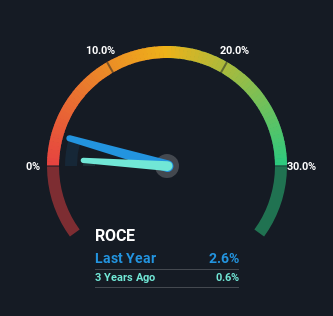If you're looking for a multi-bagger, there's a few things to keep an eye out for. Ideally, a business will show two trends; firstly a growing return on capital employed (ROCE) and secondly, an increasing amount of capital employed. This shows us that it's a compounding machine, able to continually reinvest its earnings back into the business and generate higher returns. Having said that, from a first glance at Hing Yip Holdings (HKG:132) we aren't jumping out of our chairs at how returns are trending, but let's have a deeper look.
Return On Capital Employed (ROCE): What Is It?
Just to clarify if you're unsure, ROCE is a metric for evaluating how much pre-tax income (in percentage terms) a company earns on the capital invested in its business. The formula for this calculation on Hing Yip Holdings is:
Return on Capital Employed = Earnings Before Interest and Tax (EBIT) ÷ (Total Assets - Current Liabilities)
0.026 = HK$134m ÷ (HK$7.7b - HK$2.7b) (Based on the trailing twelve months to June 2024).
So, Hing Yip Holdings has an ROCE of 2.6%. In absolute terms, that's a low return and it also under-performs the Hospitality industry average of 6.6%.
View our latest analysis for Hing Yip Holdings

While the past is not representative of the future, it can be helpful to know how a company has performed historically, which is why we have this chart above. If you'd like to look at how Hing Yip Holdings has performed in the past in other metrics, you can view this free graph of Hing Yip Holdings' past earnings, revenue and cash flow.
What Does the ROCE Trend For Hing Yip Holdings Tell Us?
When we looked at the ROCE trend at Hing Yip Holdings, we didn't gain much confidence. Around five years ago the returns on capital were 3.5%, but since then they've fallen to 2.6%. On the other hand, the company has been employing more capital without a corresponding improvement in sales in the last year, which could suggest these investments are longer term plays. It's worth keeping an eye on the company's earnings from here on to see if these investments do end up contributing to the bottom line.
The Key Takeaway
Bringing it all together, while we're somewhat encouraged by Hing Yip Holdings' reinvestment in its own business, we're aware that returns are shrinking. Since the stock has declined 38% over the last five years, investors may not be too optimistic on this trend improving either. Therefore based on the analysis done in this article, we don't think Hing Yip Holdings has the makings of a multi-bagger.
One final note, you should learn about the 4 warning signs we've spotted with Hing Yip Holdings (including 2 which are concerning) .
While Hing Yip Holdings may not currently earn the highest returns, we've compiled a list of companies that currently earn more than 25% return on equity. Check out this free list here.
Valuation is complex, but we're here to simplify it.
Discover if Hing Yip Holdings might be undervalued or overvalued with our detailed analysis, featuring fair value estimates, potential risks, dividends, insider trades, and its financial condition.
Access Free AnalysisHave feedback on this article? Concerned about the content? Get in touch with us directly. Alternatively, email editorial-team (at) simplywallst.com.
This article by Simply Wall St is general in nature. We provide commentary based on historical data and analyst forecasts only using an unbiased methodology and our articles are not intended to be financial advice. It does not constitute a recommendation to buy or sell any stock, and does not take account of your objectives, or your financial situation. We aim to bring you long-term focused analysis driven by fundamental data. Note that our analysis may not factor in the latest price-sensitive company announcements or qualitative material. Simply Wall St has no position in any stocks mentioned.
About SEHK:132
Hing Yip Holdings
An investment holding company, engages in the big data, civil explosives, property investment, financial leasing, hotel operation, and wellness elderly care businesses in Hong Kong and Mainland China.
Acceptable track record with low risk.
Market Insights
Community Narratives



